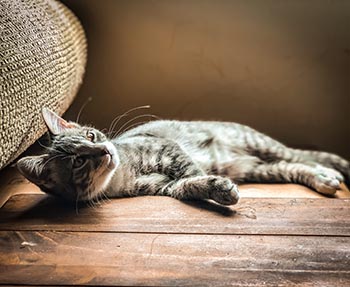
Cat Heart Disease & Congestive Failure
When it comes to cat health, most owners know at least the basic signs to look for –fluctuations in the cat’s weight, activity levels, and changes to eating habits are all things that can point to something being wrong.
Unfortunately, not all feline illnesses are easy to detect. Just like dogs, cats can develop various unseen heart problems that can result in feline heart failure if left untreated. Therefore, it’s essential to know the warning signs to look for when it comes to cat heart problems and to act quickly once you recognize them.
This article will help to clarify some of the common questions and misconceptions concerning cat heart failure. Such as, can cats have heart attacks? Or what you can do to prevent them? In addition, this will provide some important information you should know about heart disease in cats.
Warning Signs of Cat Heart Disease
Heart problems are known as the silent killer in humans, and the same can be said when it comes to our feline friends as well. By the time you notice that something’s wrong, your cat may already have serious symptoms and may have a heart disease that’s too late to treat.
So, what symptoms should you look out for?
The two most prominent symptoms of heart disease are difficulty breathing and trouble walking. Weakness in the hind legs, as well as laborious breathing because of fluid buildup, can be strong indications of the presence of heart disease.1
Congestive heart failure in cats often results in blood clots, which can cut the blood supply to the hind legs and even cause paralysis or even a cat heart attack if untreated.1
Other Signs of Cardiac Issues
Even though these symptoms are the most prominent, others can also be related to heart problems.
If your cat is vomiting and having trouble eating, becoming less playful and lethargic, or you notice bizarre changes in behavior, it could be an underlying heart problem.4
How a Cat’s Heart Works
The cat’s heart has four chambers, two at the top (left and right atria), and two at the bottom (right and left ventricles). Structurally, it is similar to a human heart, so it’s not surprising that some of the cat heart diseases are quite similar as well.
The veins carry the exhausted blood through the right atrium; then, it is pumped into the right ventricle, which pumps it to the lungs, infusing it with oxygen. Filled with oxygen, the blood goes through the left ventricle, which then pumps it throughout the entire body, after which the cycle is repeated.
Since the heart is such a complex organ, veterinary practitioners that treat it require specialized training in veterinary cardiology.
What Causes Cat Heart Disease?
There are two main categories of heart failure in cats – congenital and acquired.
Congenital diseases are those that the cat already has at birth. These can include various kitten heart problems such as holes in the heart or malformations. Congenital feline heart disorders are rare though and affect a small percentage of cats.2
Acquired diseases are those developed later in life. Common issues include an enlarged heart in cats, feline aortic thromboembolism, as well as high blood pressure. However, the most common heart issue in cats is cardiomyopathy, which is a condition in which the heart muscle itself becomes damaged.2
Cardiomyopathy can present as thickening of the ventricle tissue (hypertrophic cardiomyopathy) and is the most prevalent diagnosis.2 Other forms of cardiomyopathy include the buildup of scar tissue (restrictive cardiomyopathy), or the thinning of the muscular walls (dilated cardiomyopathy).3
Treating Cat Heart Disease
Even though cat heart disease is a severe illness, it can be managed and even treated if it is spotted early enough. At the very least, treatment can help prolong your cat’s life and ensure they enjoy a high quality of life.
In severe cases, your cat may need to be hospitalized and may require surgery. Common procedures often entail draining fluid buildup or the cat receiving oxygen treatment.2
Over the long term, medications can also be used to help control disease symptoms and allow your cat to live a comfortable and fulfilling life.
Heart disease is one of the worst diagnoses that a cat owner may hear, however, with the right treatment many cats affected with heart issues can still live a long, full life.
A comprehensive cat pet insurance plan can help your cat receive the best care and treatment possible throughout their life. While any age of pet can benefit from pet health insurance, it is most effective when purchased while pets are young to reduce the likelihood of conditions being considered pre-existing.
1 Cardiology for Cats [blog post], Retrieved on July 20th, 2019, from https://www.harlingenveterinaryclinic.com/
2 Diagnosis: Heart Disease [online article], Retrieved on August 8th, 2019, from https://www.vet.cornell.edu/departments-centers-and-institutes/cornell-feline-health-center/health-information/feline-health-topics/diagnosis-heart-disease
3 Heart Disease (Hypertrophic Cardiomyopathy) in Cats [blog post], Retrieved on July 20th, 2019, from
https://www.petmd.com/
4 Top Ten Signs of Heart Disease in Cats [blog post], Retrieved on July 20th, 2019, from
https://www.petmd.com/

